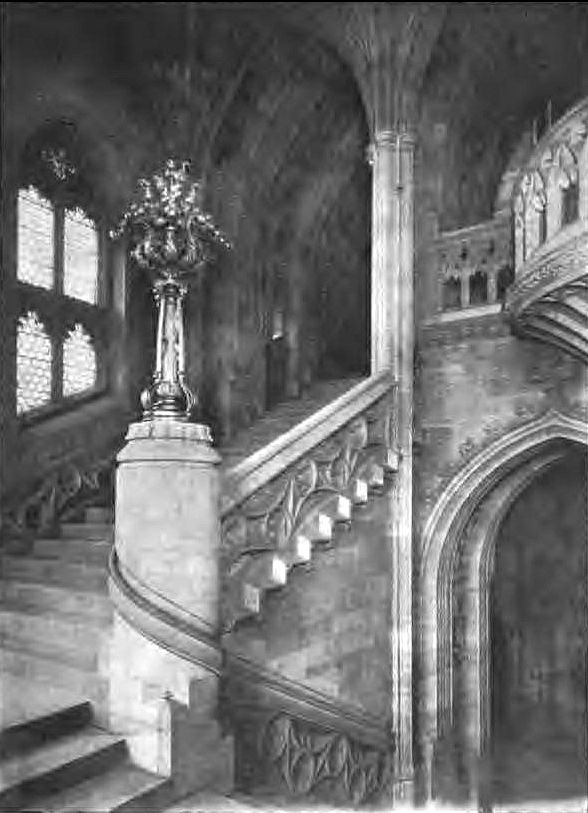Modern photographs by the author; early black-and-white ones from Henry Guppy's book (see Sources), uploaded to the Internet Archive by the University of California. [You may use these images without prior permission for any scholarly or educational purpose as long as you (1) credit the photographer or source and (2) link your document to this URL in a web document or cite it in a print one. Click on the images for larger pictures.]

The "cathedral-like" Reading Room of John Rylands Library, Deansgate, Manchester. Listed Building. Designed by Basil Champneys (1842-1935), 1890-99, in Shawk stone with two tones "which adds a Ruskinian touch to the design" (Archer 100-1). This is the heart of the building, and it has a strong sculptural element. It is presided over both by the Rylands themselves, represented in glowing white marble statues at either end, and by twenty of the great figures of printing, religion, philosophy, literature and science, such as Gutenberg and Caxton, John Bunyan and John Wesley, Francis Bacon, Shakespeare, Milton, Goethe, Isaac Newton, and John Dalton. The statues of the Rylands were by John Cassidy, and those standing on the piers of the gallery arcades, in matching red sandstone around the library, were by Robert Bridgeman & Son of Lichfield (see Wyke 69-70, 439). Rylands stands at the end here, under the Theology window, in an apse specifically designed to house his statue (Archer 100).


Left to right: (a) Looking the other way, towards the statue of Enriqueta Rylands, and the Literature and Art window, and into the arcaded reading bays on the left. (b) One of the bays, with its rich oak panelling, and the bookshelves designed by Champneys. These study bays are like little chapels to learning. Note that the light fitments and other bronze work were commissioned directly from Singer's of Frome, Somerset. John Archer writes that Singer's work "is a notable Art Nouveau feature in its own right" (cf., for example, that firm's beautiful wrought-iron gates of Sheffield Town Hall, from around the same time). Note also the two tones of the striated stone columns.
.


The two great windows either end of the Reading Room, by Charles Earner Kempe (1837-1907), protégé of G F Bodley. Left to right: (a) The Literature and Art window to the east. (b) Close-up of figures from the window . (c) Theology window, at the west end, depicting prophets and theologians The figures shown close up in the Literature and Art window are (from the left): Plato, Aristotle, Lucretius, Cicero (holding De Senectute, Aeschylus, Raphael (holding a palette) and Beethoven (holding a baton and a sheet of music). Like the statues along the galleries, they are named below. Mrs Rylands herself was closely concerned with all such details.



Left to right: (a) The octagonal Bible Room, one of the most notable rooms apart from the main hall (Guppy, illustration 14). (b) Corner with card catalogue and bay window, and plaster-panelled ceiling above. (c) Gallery corridor (Guppy, illustration 36).. The Bible Room gives a good view of Champneys' elegant bookcases, "which remain smooth-running and dustproof" (Archer 101), while the green glazing in the bays behind the catalogue in the central picture, like the elaborate light fittings, were supplied by Singer's. The delicate modelling of the ceiling panels was by George Frampton, whom Champneys had recommended to Mrs Rylands for the more important sculptural work in the library (see Wyke 69) As for the corridor, Archer explains: "the laterally deep central piers are penetrated at gallery level by a passage. Each bay is arcaded at both levels. The lower piers are divided by central piers, the upper arcades span the full bay" (100). The graceful vaulting adds to the cathedral-like atmosphere.


Two further illustrations from Guppy. Left: The East Cloister (illustration 35). Right: The main staircase (illustration 6).
Since visitors now enter through a new visitors' wing on the Spinningfield side (see "The Building"), it is easy to miss the ground floor, and the "very fine vaulted entrance hall and winding vaulted staircase" described in the listing text. As Archer says of this part "Neither the extravagence nor the drama of the design can be denied" (100). Not seen here, but standing prominently against the wall in the vestibule, is John Cassidy's large allegorical tableau, three figures in the same Shawk sandstone as the rest of the interior, representing Theology Directing the Labours of Science and Art, installed in 1898. The view through the east cloister also helps to justify descriptions of this memorable building as cathedral-like. Nothing could be more suitable for the world-class collection of theological and other texts housed here.
The library's many items of Victorian interest range from the manuscript of Bishop Heber's famous hymn, "From Greenland's Icy Mountains,", to its extensive printed and manuscript collections.of work by or relating to John Ruskin.
Related Material
- John Rylands Library, Manchester. 1: Exterior
- Statue of John Rylands, by John Cassidy
- Statue of Enriqueta Rylands, by John Cassidy
- Theology Directing the Labours of Science and Art
Sources
Archer, John H. G. "John Rylands Library." In Manchester, by Clare Hartwell. Pevsner Architectural Guides. London: Penguin, 2001. 96-101. Print.
"The Building.".The University of Manchester: The John Rylands Library. Web. 1 August 2012.
Guppy, Henry (Librarian). The John Rylands Library: A Brief Record of Twenty-One Years' Work. Manchester: Manchester University Press / London: Longmans, Green & Co., 1921. Internet Archive. Web. 1 August 2012.
"John Rylands Library and Attached railings, gates and lamp standards." British Listed Buildings. Web. 1 August 2012.
Wyke, Terry, with Harry Cocks. Sculpture of Greater Manchester. Liverpool: Liverpool University Press, 2004. Print.
Last modified 5 August 2012